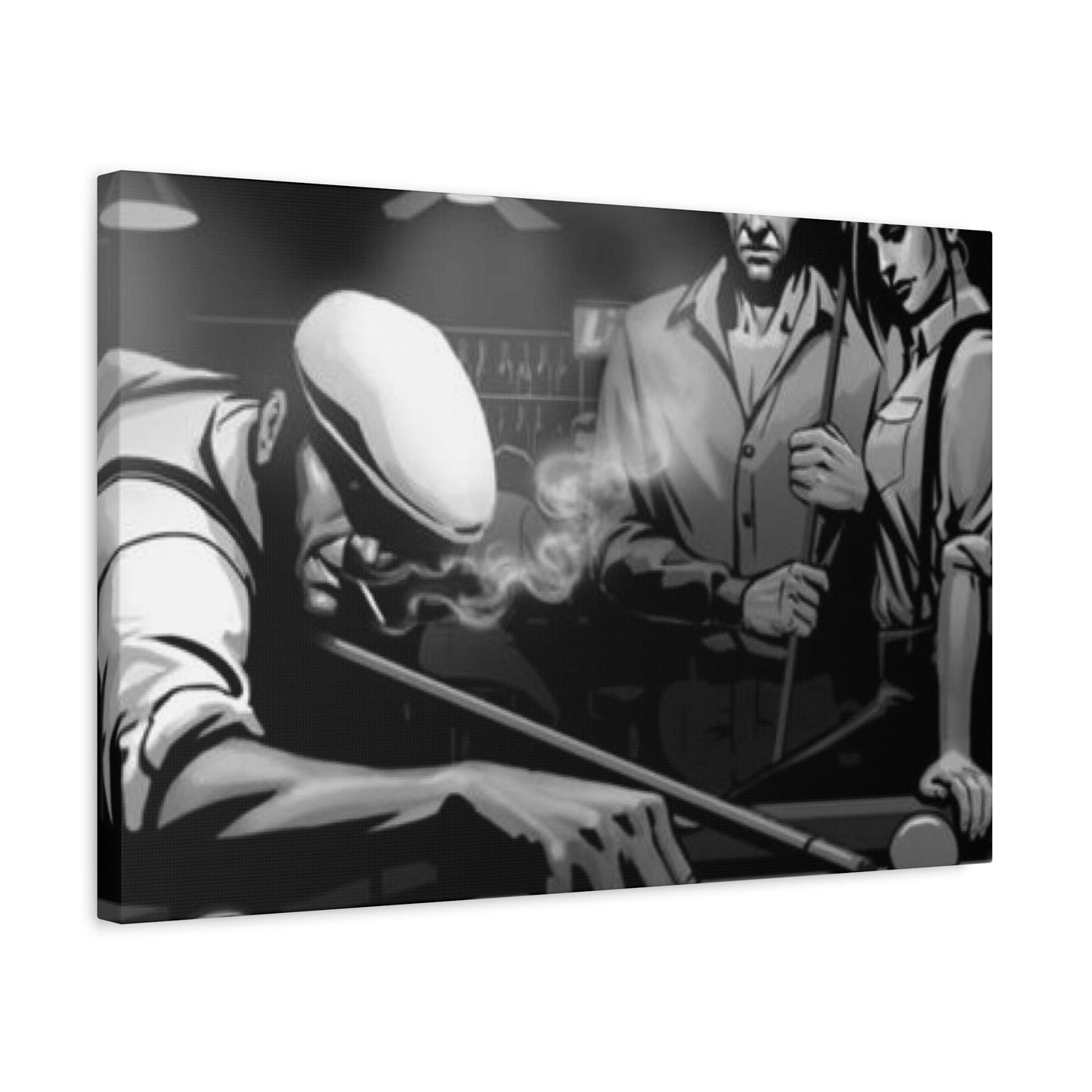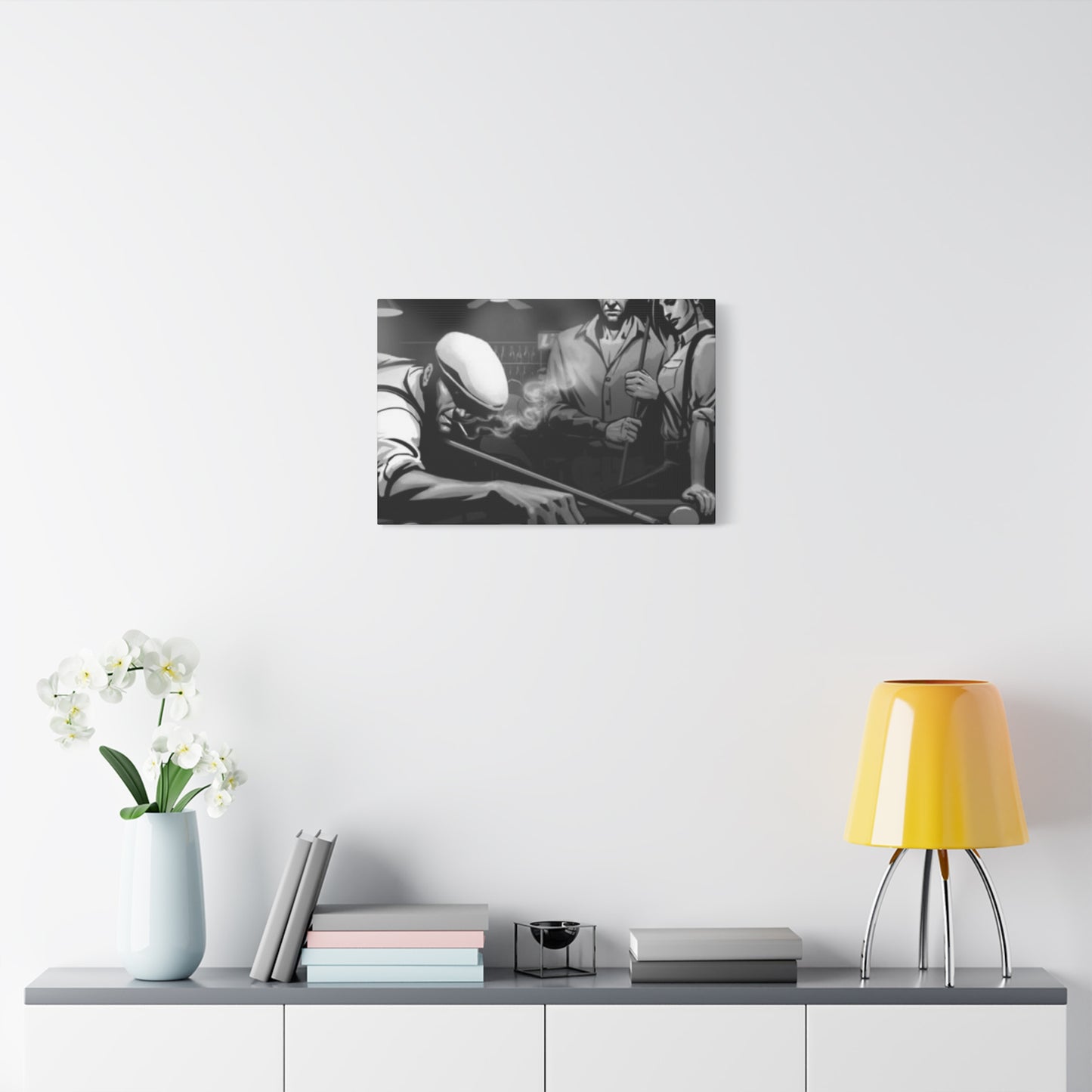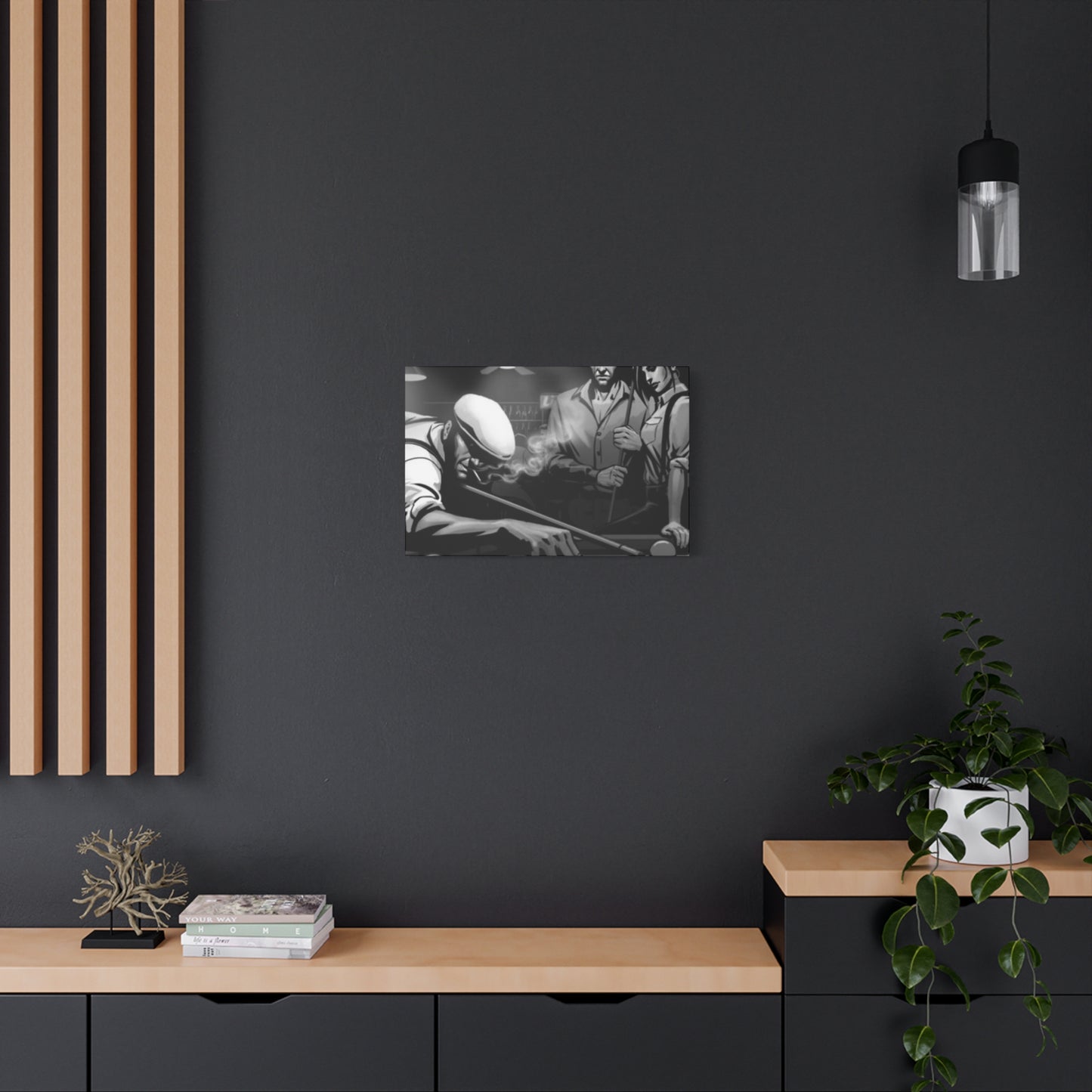The Ultimate Guide to Man Playing Pool Wall Art: Bringing Dynamic Energy and Style to Your Home
The world of recreational pastimes has long been immortalized through various artistic mediums, and few subjects capture the essence of leisure, skill, and timeless tradition quite like depictions of seasoned individuals engaged in the noble game of billiards. These artistic representations serve as windows into moments frozen in time, celebrating not just the sport itself but the stories, emotions, and cultural significance that surround it. The visual portrayal of experienced players at the billiard table transcends mere decoration, becoming a testament to dedication, patience, and the quiet dignity found in mastering a craft over decades.
Canvas artwork featuring mature gentlemen engaged in billiards represents more than simple sporting imagery. These pieces capture the atmospheric essence of dimly lit establishments where concentration meets camaraderie, where the soft click of ivory against felt creates its own rhythm, and where every angle, every calculation tells a story of experience accumulated through countless games. The artistic merit of such depictions lies in their ability to transport viewers to these intimate spaces, evoking memories and emotions that resonate across generations.
The cultural significance of billiards as both sport and social ritual cannot be overstated. For centuries, the game has served as a gathering point for communities, a test of mental acuity and physical precision, and a symbol of refined leisure. When artists choose to immortalize this subject, they acknowledge its place in our collective consciousness. The weathered hands gripping a cue, the intense focus in aged eyes studying angles, the casual confidence of stance born from years of practice—these elements combine to create compositions that speak to something fundamental about human nature, our desire for excellence, and our appreciation for activities that reward patience and skill.
Traditional Appeal: Experienced Players on Display
The aesthetic appeal of artwork showcasing veteran billiard players extends far beyond simple nostalgia. These compositions tap into universal themes that resonate with diverse audiences. The imagery communicates values of perseverance, the dignity of aging, the beauty found in practiced skill, and the social dimensions of competitive recreation. When viewers encounter such artwork, they often find themselves reflecting on their own experiences, memories of time spent in similar environments, or aspirations toward mastering skills that demand dedication.
From an artistic perspective, these subjects offer remarkable opportunities for exploring light, shadow, and atmosphere. The typical billiard hall environment, with its characteristic lighting fixtures casting pools of illumination over green felt while shadows gather in corners, provides dramatic contrasts that challenge and inspire artists. The interplay between bright table surfaces and darker surroundings creates natural focal points that draw the eye and establish mood. Skilled artists leverage these environmental qualities to craft compositions that feel both intimate and expansive, specific yet universal.
The human element in these artworks carries equal importance to the environmental setting. The physical form of a mature individual bent over a table, calculating trajectories and force, offers artists opportunities to explore anatomy, posture, and the visual poetry of concentration. The character etched into weathered faces, the stories suggested by worn clothing, the wisdom implied by confident stance—these elements transform simple sporting scenes into profound character studies. Each wrinkle, each gesture, each expression becomes a brushstroke in a larger narrative about time, experience, and the pursuit of excellence.
Color palettes in these artworks typically reflect the traditional environments associated with billiards. Deep greens from table felt, rich browns of wood paneling and furniture, amber tones from vintage lighting, and the occasional splash of color from clothing or accessories create harmonious compositions that feel both grounded and sophisticated. These color choices evoke specific eras while maintaining timeless appeal, allowing the artwork to complement various interior design schemes while retaining its distinctive character.
Bringing Historical Atmosphere Into Modern Spaces
Incorporating artwork depicting experienced billiard players into contemporary living spaces creates fascinating dialogues between past and present. These pieces serve as anchors that ground modern interiors with touches of tradition and substance. The contrast between sleek contemporary design elements and the warm, storied atmosphere of billiard hall imagery often produces unexpectedly harmonious results. The key lies in understanding how these artworks function within spaces, not as incongruous historical artifacts but as bridges connecting different aesthetic sensibilities.
The versatility of such artwork surprises many who initially perceive it as suitable only for specific environments like game rooms or entertainment spaces. While these pieces certainly excel in such contexts, their applicability extends much further. Living rooms benefit from the conversational qualities these artworks bring, offering guests natural talking points and adding layers of character to spaces that might otherwise feel impersonal. Studies and home offices gain gravitas and warmth from such additions, creating environments that balance professionalism with approachability. Even dining areas can accommodate these pieces, particularly when the artwork emphasizes the social aspects of the game, reinforcing themes of gathering and shared experience.
Scale considerations play crucial roles in successfully integrating these artworks into various spaces. Large-scale pieces make bold statements, commanding attention and establishing themselves as focal points around which other design elements orbit. These substantial works particularly suit spacious areas with high ceilings or expansive wall surfaces. Medium-sized pieces offer flexibility, working well as standalone features or as components within gallery wall arrangements. Smaller compositions provide opportunities for creating intimate moments within larger spaces, drawing viewers closer for detailed examination and contemplation.
The framing and presentation of billiard-themed artwork significantly impacts its integration into interior environments. Traditional wood frames with distressed finishes enhance the vintage character of the imagery, creating cohesive visual statements that transport viewers to earlier eras. Contemporary frame styles, including minimalist metal options or frameless canvas wraps, modernize the presentation while allowing the artwork itself to bridge temporal gaps. The choice between these approaches depends on the overall design philosophy of the space and the desired balance between historical authenticity and contemporary sensibility.
Lighting represents another critical consideration when displaying such artwork. These pieces often feature dramatic lighting within the composition itself, with illuminated billiard tables contrasting against darker surroundings. When hanging these works, thoughtful lighting design can enhance their impact substantially. Adjustable spotlights or picture lights allow for highlighting specific areas within the composition, emphasizing details and creating depth. Ambient lighting in the surrounding space should complement rather than compete with the artwork, maintaining the moody atmosphere that characterizes many of these pieces.
Enduring Scenes: Mature Players at Green Felt Tables
The specific appeal of artwork featuring mature individuals engaged in billiards stems from multiple interconnected factors. These compositions celebrate experience in an age that often privileges youth, offering counternarratives about value, wisdom, and the rewards of dedication practiced over lifetimes. The visual representation of aged hands confidently manipulating cues, weathered faces calculating complex angles, and bodies moving with practiced efficiency challenges cultural biases while celebrating the beauty found in seasoned skill.
From compositional perspectives, these subjects offer artists rich opportunities for storytelling. Every element within the frame contributes to larger narratives. The condition of the billiard table itself might suggest countless games played across years. Personal effects visible in the scene—perhaps a worn hat, a favorite beverage, or distinctive jewelry—add layers of personality and history. The surrounding environment, whether a private basement retreat or a bustling public establishment, contextualizes the moment within broader social frameworks. These accumulated details transform simple sporting scenes into complex character studies and environmental portraits.
The emotional resonance of such imagery extends across surprisingly diverse audiences. Younger viewers often respond to the aspirational qualities these works suggest—the promise that dedication and practice lead to mastery, that aging brings wisdom rather than decline, that passions pursued across lifetimes provide meaning and satisfaction. Middle-aged audiences frequently experience recognition and validation, seeing reflections of their own journeys toward expertise in their chosen fields. Older viewers often encounter profound nostalgia and affirmation, finding their own experiences and values represented and honored through artistic medium.
These artworks also function as historical documents, preserving visual records of recreational culture as it existed in earlier eras. The clothing styles, the specific designs of billiard equipment, the architectural details of game room environments, and the social configurations depicted all provide insights into how people lived, socialized, and entertained themselves in previous generations. This documentary quality adds additional layers of value beyond pure aesthetic appeal, making these pieces educational resources as well as decorative objects.
The technical execution of such artwork varies widely depending on artistic style and medium. Photorealistic approaches emphasize precise detail, capturing every texture and shadow with meticulous accuracy. These works impress with their technical virtuosity while creating almost photographic records of their subjects. Impressionistic interpretations prioritize mood and atmosphere over precise detail, using loose brushwork and suggestive forms to evoke emotional responses. Abstract approaches might focus on essential elements—the geometric patterns created by cues and balls, the interplay of light and shadow, the fundamental shapes that define billiard spaces—distilling scenes to their core visual components.
Welcoming Reminiscence Through Billiard Room Imagery
The nostalgic dimensions of artwork featuring experienced billiard players deserve particular attention, as nostalgia serves as a powerful emotional driver in art appreciation and acquisition. These pieces tap into collective memories of spaces where time seemed to slow, where the outside world receded as concentration focused on precise calculations and careful execution. For many viewers, such imagery recalls specific memories—time spent with fathers or grandfathers, evenings in social clubs, formative experiences learning both the game and larger life lessons about patience, strategy, and graceful acceptance of both victory and defeat.
This nostalgic appeal functions differently across generational cohorts. For those who came of age when billiard halls represented common social destinations, these artworks provide direct connections to lived experience. The sights, sounds, and even imagined smells of these environments flood back when viewing well-executed representations. Middle generations who experienced these spaces less directly often possess inherited nostalgia, connections formed through family stories, film and television portrayals, and cultural mythology surrounding these environments. Younger audiences frequently experience aspirational nostalgia, attraction to imagined authenticity and substance that these historical scenes represent.
The power of nostalgia in interior design should not be underestimated. Spaces that incorporate nostalgic elements create emotional warmth and depth that purely contemporary designs sometimes lack. These touches of the past provide grounding and continuity, reminding inhabitants of broader temporal contexts and connections to history. Billiard-themed artwork serves this function particularly well because the subject itself inherently involves tradition, ritual, and the transmission of skills and knowledge across generations.
Creating rooms or spaces that honor specific interests or hobbies represents another dimension of how this artwork functions in residential environments. Dedicated game rooms naturally accommodate billiard-themed art, creating thematic coherence and reinforcing the purpose of the space. However, the concept extends beyond literal recreation rooms. A reading nook might incorporate such artwork to suggest quiet concentration and solitary satisfaction in practiced skills. A home bar area benefits from the social dimensions these images convey, establishing atmosphere that encourages gathering and conversation.
The role of artwork in establishing social connections within homes merits consideration. Distinctive pieces like those depicting seasoned billiard players serve as conversation starters, providing guests with natural entry points for discussion. These works prompt sharing of personal stories, memories, and connections to the subject matter. They signal host interests and values, suggesting appreciation for tradition, skill, and particular aesthetic sensibilities. In this way, the artwork becomes not merely decorative but actively social, facilitating interactions and deepening relationships.
Craftsmanship Captured: Expressions of Recreational Excellence
The artistic representation of skilled billiard play necessarily involves depicting craftsmanship itself—both the physical craft of the game and the artistic craft of representation. These layers of skill create rich viewing experiences where audiences simultaneously appreciate subject matter and execution. The technical demands of billiards, requiring precise control over angles, force, and spin, parallel the technical demands of realistic artistic rendering, where accurate proportions, convincing lighting, and effective composition separate amateur efforts from professional achievements.
Artists who successfully capture billiard scenes demonstrate understanding of both visual art principles and the sport itself. They must comprehend how experienced players position their bodies, how hands properly grip cues, how eyes track from cue ball to target and back again. These physical details matter because knowledgeable viewers immediately recognize inaccuracies, which undermine the artwork's credibility and impact. Conversely, accurate representations signal the artist's commitment to authenticity and research, enhancing viewer trust and engagement.
The psychological dimensions of skill representation add further complexity. Effective artwork captures not just physical positioning but mental state—the intense concentration required for difficult shots, the relaxed confidence of experienced players executing routine techniques, the mix of calculation and intuition that characterizes expert performance. Artists convey these internal states through external markers: facial expressions, body tension or relaxation, gaze direction, and overall posture. Master artists achieve remarkable specificity, allowing viewers to almost read subjects' thoughts as they contemplate their next moves.
Environmental details contribute substantially to the sense of authentic skill representation. The condition of equipment provides visual shorthand for experience levels and contexts. Professional-grade tables with perfect felt, precisely calibrated rails, and high-quality balls suggest serious play and dedicated practitioners. More worn equipment indicates well-used recreational spaces where countless games have created character through accumulated wear. These environmental details enhance narrative dimensions, suggesting backstories and contexts that enrich viewer understanding and emotional connection.
The social contexts of skilled play provide additional layers for artistic exploration. Billiards functions both as solitary practice and social competition. Artwork might depict lone players absorbed in practice, emphasizing the meditative qualities of repeated technique refinement. Alternatively, scenes might capture competitive moments, with opponents watching intently as shots unfold, their body language revealing respect, concern, or admiration. Still other compositions might emphasize the teaching dimension, showing experienced players sharing knowledge with eager students, perpetuating traditions across generations.
Atmospheric Halls: Billiard Environments in Stunning Visual Form
The environmental settings associated with billiards offer artists rich subjects for atmospheric rendering. These spaces possess distinctive characteristics that translate powerfully to visual art. The architectural features of traditional billiard halls—high ceilings with exposed beams, substantial wood paneling, large windows that might be curtained to control natural light, and the distinctive overhead lighting fixtures that illuminate tables while leaving surroundings in relative shadow—create dramatic spaces with inherent visual interest.
These environments also carry specific cultural and historical associations that add depth to artistic representations. The golden age of billiard halls in the late nineteenth and early twentieth centuries established design conventions that persist in collective imagination. The substantial woodwork, brass fixtures, and careful craftsmanship that characterized these spaces reflected both the game's status as a gentleman's pursuit and the era's general approach to public and semi-public spaces. Even contemporary billiard rooms often echo these design principles, maintaining connections to historical precedents.
The lighting in billiard environments deserves special attention as a defining characteristic. The focused illumination over tables creates islands of brightness in otherwise dim spaces, establishing natural focal points while contributing to the intimate, concentrated atmosphere that characterizes serious play. This lighting pattern creates dramatic visual contrasts that artists exploit to great effect, using the interplay between illuminated and shadowed areas to guide viewer attention, create depth, and establish mood. The specific quality of light matters as well—the warm amber tones of traditional incandescent fixtures versus cooler modern LED alternatives significantly impact atmospheric qualities.
The objects and artifacts that populate billiard environments provide additional material for artistic inclusion. Cue racks mounted on walls, chalk holders, scoring devices, furniture for spectators, and personal effects belonging to regular patrons all contribute to the sense of lived-in authenticity. These elements transform generic spaces into specific places with character and history. Artists selecting which details to include and emphasize make crucial decisions that shape how viewers perceive and respond to the depicted environments.
Sound represents an intriguing challenge in visual art depicting billiard environments. Obviously, paintings and prints cannot directly reproduce the distinctive acoustic character of these spaces—the sharp click of balls colliding, the soft whisper of cues sliding through bridges, the muted conversations of players and spectators, the ambient sounds of surrounding environments. However, skilled artists can suggest auditory experiences through visual means, creating compositions that viewers almost hear. This synesthetic quality, where visual elements trigger other sensory responses, marks sophisticated artistic achievement.
Traditional Recreation Captured Through Canvas Techniques
The specific medium of canvas for billiard-themed artwork carries both practical and aesthetic significance. Canvas provides durable surfaces that withstand environmental conditions well, making these works suitable for various installation locations including spaces where temperature and humidity might fluctuate. The texture of canvas, visible through paint layers, adds tactile dimensionality that enhances viewing experiences, particularly when observed closely. This surface quality contributes to the handmade, crafted character that suits traditional subject matter.
Canvas also possesses strong historical associations with fine art, connecting contemporary productions to centuries of painting tradition. When billiard scenes appear on canvas, they benefit from these associations, gaining cultural legitimacy and artistic gravitas. The medium signals seriousness of purpose, distinguishing these works from purely commercial or decorative items. For collectors and appreciators, canvas pieces often represent more substantial investments and commitments than alternative formats.
The production techniques for canvas artwork impact final results significantly. Original paintings on canvas represent unique objects with inherent value derived from their singularity. Each brushstroke bears the artist's direct touch, creating surfaces rich with texture and variation. Even when viewed from distances where individual marks merge into coherent imagery, the surface quality distinguishes paintings from reproductions. Limited edition canvas prints, often called giclee prints when produced to high standards, offer more accessible entry points while maintaining many desirable canvas characteristics. These reproductions use archival inks and processes that ensure longevity and color accuracy.
The sizing and stretching of canvas affects how artwork presents itself and integrates into spaces. Gallery-wrapped canvases, where the printed or painted image continues around the stretcher frame edges, create finished appearances without requiring additional framing. This contemporary presentation style suits modern interiors while reducing costs and simplifying installation. Traditional stretched canvases designed for framing provide more flexibility for customization, allowing owners to select frames that coordinate with specific design schemes or personal preferences.
The care and maintenance of canvas artwork requires some attention but remains straightforward. These pieces should be protected from direct sunlight to prevent fading, though quality inks and paints resist degradation well under normal lighting conditions. Regular dusting with soft brushes keeps surfaces clean, while the occasional use of appropriate cleaning solutions addresses any accumulated grime. Avoiding high-moisture environments prevents potential damage to canvases and stretcher frames. With basic care, canvas artwork depicting billiard scenes can provide enjoyment across generations.
Retro Recreation: Capturing Historical Game Evening Atmosphere
The concept of game nights as social institutions has evolved considerably across decades, and artwork depicting these gatherings serves as cultural documentation of changing recreational patterns. Historical game nights centered around billiards possessed particular character—they were predominantly male social spaces, though this exclusivity varied by location and era. The rituals surrounding these gatherings, from the selection of opponents to the informal wagering that often accompanied games, created structured social interactions that strengthened community bonds.
Artistic representations of these historical game nights capture more than mere recreation. They document social structures, class distinctions, and cultural values. The clothing worn by participants reveals economic status and fashion sensibilities. The quality of facilities and equipment indicates the establishments' positions within community hierarchies. The body language and interactions between depicted figures suggest relationship dynamics—friendly rivalries, mentorship connections, casual acquaintanceships formed through regular attendance. These social dimensions transform simple sporting scenes into complex sociological documents.
The evolution of game night culture provides context for appreciating artwork depicting earlier eras. Contemporary viewers often romanticize past recreational patterns, viewing them through nostalgic lenses that emphasize positive qualities while minimizing less appealing aspects. Historical game nights offered valuable social connections and structured leisure in times when entertainment options were more limited than today. They provided regular rhythms that structured weekly routines, anticipated gatherings that punctuated otherwise monotonous schedules. For many participants, these occasions represented important social outlets and sources of friendship.
The competitive dimensions of game night billiards deserve consideration. While friendly games certainly occurred, more serious competitions with meaningful stakes also featured prominently. These competitive contexts elevated play beyond casual recreation, demanding concentration, skill, and mental fortitude. The tension and drama of close matches provided entertainment for both participants and spectators. Artwork capturing these competitive moments freezes them in time, allowing viewers to vicariously experience the excitement and suspense.
The refreshments and consumption associated with game nights add another layer to their cultural significance. Billiard halls and similar establishments often served alcohol, and the combination of drinking and playing created specific social atmospheres. The social lubrication provided by moderate drinking facilitated conversation and bonding while occasionally leading to excess with attendant consequences. Artists including these elements in their work acknowledge these dimensions of billiard hall culture, creating more complete and honest representations of historical recreational patterns.
Eternal Leisure Compositions for Interior Environments
The appeal of leisure-themed artwork extends across multiple dimensions of human psychology and aesthetic preference. Scenes depicting recreational activities allow viewers to temporarily escape pressures and demands, imaginatively participating in moments of relaxation and enjoyment. This escapist function serves genuine psychological needs, providing mental respite that contributes to overall wellbeing. When these scenes also possess artistic merit and aesthetic sophistication, they fulfill dual roles—offering both psychological benefits and visual pleasure.
The selection of specific leisure activities for artistic representation matters significantly. Billiards occupies an interesting middle ground between purely physical sports and entirely sedentary pastimes. The game requires physical skill and precision while also demanding mental calculation and strategic thinking. This combination creates visually interesting moments where physical and mental effort coincide, offering artists opportunities to depict concentration, tension, and the satisfaction of successful execution. The relatively stationary nature of the activity allows for sustained poses that artists can observe and render with care.
Interior wall compositions benefit from leisure-themed artwork in multiple ways. These pieces establish relaxed, welcoming atmospheres that put inhabitants and visitors at ease. They signal that spaces serve not merely functional purposes but also provide for enjoyment and recreation. The specific activity depicted suggests values and interests—choosing billiard imagery indicates appreciation for skilled competition, traditional recreation, and perhaps masculine aesthetics, though this gender association has softened considerably over time.
The scale and format of leisure artwork influences its impact within interior environments. Panoramic compositions capturing entire billiard halls or game rooms establish expansive spatial contexts, potentially making smaller actual rooms feel larger through implied depth and space. Closer, more intimate compositions focus on individual players or specific moments, creating personal connections between viewers and subjects. The choice between these approaches depends on both available wall space and desired emotional effects.
Color coordination between leisure artwork and surrounding interior elements affects overall design coherence. Billiard scenes often feature specific color palettes dominated by the distinctive green of table felt, rich wood tones, and amber lighting effects. These colors coordinate well with traditional decor featuring natural materials, leather upholstery, and warm metallic accents. Contemporary spaces can accommodate these pieces by selecting neutral backgrounds that allow the artwork to provide color accents, or by strategically incorporating complementary colors in accessories and furnishings.
Experienced Player Depictions: Visual Chronicles of Dedication
The artistic focus on experienced, mature players rather than young athletes creates specific narrative and aesthetic effects. These subjects embody accumulated knowledge and practiced skill developed across lifetimes. Their weathered appearances testify to time invested and experiences accumulated. This focus celebrates aging as a positive process that brings competence and wisdom rather than merely decline. In cultures that often devalue aging, such representations offer valuable counternarratives.
The visual characteristics of aged subjects provide rich material for artistic exploration. The topography of weathered faces, with lines and creases mapping years of expressions and emotions, offers textural complexity that younger, smoother features cannot provide. Aged hands, perhaps gnarled with arthritis yet still capable of precise cue control, tell stories of adaptation and perseverance. Postures that might betray some physical limitation while maintaining essential capabilities demonstrate the human capacity for adjustment and continued engagement despite bodily changes.
These subjects also naturally evoke contemplation of mortality and legacy. Viewers recognize that the depicted moments represent finite slices of finite lives, making them more precious and meaningful. This awareness adds poignancy and depth to viewing experiences, transforming casual observation into more profound engagement. The question of what legacies these individuals leave—skills taught to others, memories created with companions, personal satisfactions accumulated—adds philosophical dimensions to ostensibly simple sporting scenes.
The relationship between experience and performance in billiards differs from physical sports where youth often correlates with peak performance. While physical changes associated with aging might slightly affect play, the mental and strategic dimensions of billiards mean that experienced players often continue performing at high levels well into later life. This quality makes the sport particularly suitable for artistic celebration of aging expertise, as depicted subjects can credibly represent both advanced age and maintained excellence.
The dignity with which experienced players conduct themselves provides another appealing dimension for artistic representation. The quiet confidence, the economical movements, the lack of showmanship or excessive display—these qualities suggest inner security and genuine mastery that need not announce themselves. Such restraint and self-possession represent aspirational qualities that resonate with viewers regardless of their own relationships to billiards specifically.
Documentary Excellence: Accomplished Players in Print
The transformation of billiard scenes into print media extends their availability and accessibility. While original paintings remain unique objects owned by single collectors, high-quality prints allow broader audiences to enjoy these artistic works. This democratization of access serves important cultural functions, making artistic achievements available to people regardless of economic circumstances or geographic locations. The proliferation of print technology has revolutionized how art functions in society, enabling mass appreciation of works that might otherwise remain locked in exclusive collections.
Canvas print technology has advanced remarkably, producing reproductions that capture extraordinary detail and color accuracy. Modern printing processes can reproduce subtle tonal gradations, complex color relationships, and fine details that earlier reproduction methods rendered poorly or lost entirely. These technical advances mean that contemporary prints can provide viewing experiences approaching those of originals, particularly when observed from normal viewing distances. The surface textures of canvas prints add tactile dimensionality that flat paper prints cannot match.
The market for billiard-themed prints reflects broader interest in traditional recreational subjects and nostalgia-driven decor. Multiple producers offer various interpretations ranging from photorealistic renderings to loose, impressionistic approaches. This variety ensures that consumers can find works matching their specific aesthetic preferences and price points. The availability of different sizes accommodates various spaces and purposes, from substantial pieces that dominate walls to smaller works suitable for gallery arrangements or modest rooms.
The framing and finishing options for prints significantly impact their final presentations. Simple gallery wraps provide contemporary, minimalist presentations that suit modern interiors. Traditional frames with matting create more formal appearances appropriate for classic decor schemes. The selection between these options depends on personal taste, intended installation locations, and relationships with surrounding design elements. Many print providers offer customization options, allowing purchasers to specify exact dimensions, frame styles, and other details.
The sustainability and longevity of modern prints have improved substantially. Archival inks resist fading when protected from direct sunlight, maintaining color vibrancy for decades under normal conditions. Canvas materials designed for printing withstand environmental fluctuations better than historical canvases that might crack or deteriorate. These improvements mean that contemporary prints represent sound long-term investments that can provide enjoyment across many years without significant degradation.
Character and Warmth Integration Through Visual Expression
The capacity of artwork to fundamentally alter the character of interior spaces represents one of art's most valuable practical functions. Empty walls create cold, impersonal environments that feel incomplete and uninviting. Strategic artwork placement transforms these spaces, adding warmth, interest, and personality. Billiard-themed pieces particularly excel at this transformation because they inherently convey warmth through their typically amber-toned lighting, their human subjects engaged in absorbing activities, and their associations with leisure and social connection.
Character in interior design involves creating spaces that feel distinctive and personal rather than generic or anonymous. Mass-produced furniture and standardized layouts create challenges for establishing character, as many contemporary homes and apartments share similar features. Thoughtfully selected artwork provides efficient solutions, allowing inhabitants to differentiate their spaces and express individual tastes and interests. A well-chosen piece depicting an experienced billiard player immediately distinguishes a room, suggesting specific values and aesthetic sensibilities.
The warmth that artwork contributes operates on both visual and psychological levels. Visually, warm color temperatures in the artwork itself radiate throughout spaces, counterbalancing cooler tones that might dominate other design elements. The amber lighting typically depicted in billiard scenes contributes particularly strong warm effects. Psychologically, the human subjects and narrative content create emotional warmth by suggesting companionship, leisure, and the satisfaction of engaging in meaningful activities. This emotional warmth makes spaces feel more welcoming and comfortable.
The relationship between artwork and other design elements requires careful consideration for maximum impact. Pieces should complement rather than clash with existing furniture, color schemes, and decorative objects. This doesn't require exact matching—in fact, some contrast often proves desirable, creating visual interest through variation. Rather, successful integration involves finding harmonious relationships where different elements work together toward cohesive overall effects. Billiard artwork's typical color palettes facilitate this integration, as warm wood tones and green felt coordinate with numerous design approaches.
The personal meaning that inhabitants derive from their selected artwork enhances spaces in ways that purely decorative choices cannot achieve. When artwork resonates with personal interests, memories, or aspirations, it becomes more than mere decoration—it becomes meaningful expression of identity and values. For billiard enthusiasts, such artwork celebrates personal passions. For those who appreciate skilled craftsmanship, it honors values of excellence and dedication. For individuals valuing tradition and history, it connects present spaces with cultural heritage.
Passion Recognition Through Artistic Medium
The celebration of specific interests and hobbies through artistic representation validates their importance and enriches the lives of enthusiasts. Billiards, like many traditional games and sports, possesses dedicated communities of practitioners who invest substantial time and energy developing skills and participating in the culture surrounding the activity. For these individuals, artwork depicting their passion serves multiple purposes—it beautifies their environments, signals their interests to others, and reinforces personal identity connections to the activity.
The psychology of hobby-related decor involves self-concept and identity expression. The activities we choose to pursue and the time we allocate to them reflect values, priorities, and aspects of personality. Displaying artwork related to these activities makes private interests publicly visible, integrating them into domestic environments where we spend considerable time. This integration acknowledges that hobbies constitute significant parts of life rather than trivial diversions, deserving recognition and celebration.
The social dimensions of hobby-related artwork extend its functions beyond personal satisfaction. When guests encounter such pieces, they gain insights into host interests and values, providing conversation foundations and potential connection points. For fellow enthusiasts, the artwork signals shared interests and may prompt discussions about personal experiences, favorite techniques, memorable games, or other aspects of the shared passion. Even for those unfamiliar with the activity, such artwork provides educational opportunities and might spark interest in learning more.
The inspirational and motivational functions of passion-related artwork deserve consideration. Seeing expert practitioners depicted in artistic form can inspire viewers to pursue their own skill development more diligently. The imagery serves as visual reminders of the satisfactions that dedicated practice can bring, encouraging continued engagement during periods when motivation might flag. The celebration of mastery implicit in such artwork reinforces the value of long-term commitment to skill acquisition.
The documentation of hobby culture represents another important function. Activities and their associated cultures evolve over time, with practices, equipment, and social contexts changing across generations. Artwork preserving historical approaches and environments serves documentary purposes, recording how activities were practiced in earlier periods. This historical documentation gains value as time passes, becoming increasingly important for understanding cultural history and the evolution of recreational practices.
Mature Gentlemen at Billiard Stations: Tribute Representations
The specific framing of billiard artwork as tribute or homage adds layers of meaning and purpose. Tribute implies recognition of worth, acknowledgment of value, and expression of respect or admiration. When artwork depicting experienced players is understood as tribute, it moves beyond simple representation into the realm of honor and celebration. This framing elevates both subject matter and artistic work, suggesting that what is depicted merits special attention and recognition.
The concept of paying tribute through art has deep historical roots. Portrait paintings traditionally honored important individuals, preserving their likenesses for posterity and asserting their significance. Historical and religious paintings commemorated important events and figures, ensuring their remembrance across generations. Genre paintings celebrated everyday life and ordinary people, asserting the dignity and worth of common experiences. Billiard artwork continues these traditions, honoring the game, its practitioners, and the cultures surrounding it.
The subjects worthy of tribute evolve across cultural and historical contexts. Contemporary values that emphasize inclusivity and democratization have expanded our understanding of what merits artistic commemoration. Activities that might once have been considered insufficiently dignified for serious artistic treatment now receive full recognition. This expansion allows for richer, more diverse artistic landscapes that reflect the actual breadth of human experience and interest. The acceptance of recreational subjects like billiards as legitimate artistic subjects reflects these evolving values.
The technical quality of tribute artwork matters significantly. Honoring subjects through careless or unskilled representation would constitute something closer to insult than tribute. Genuine tribute requires artistic excellence that matches the worthiness of subjects. This necessity means that successful billiard tribute art demonstrates mastery of composition, lighting, color, anatomy, and all other relevant artistic skills. The care evident in execution becomes part of the tribute itself, showing that artists valued their subjects sufficiently to invest significant time and effort in worthy representation.
The emotional responses that tribute artwork seeks to evoke differ somewhat from other artistic categories. While beauty and aesthetic pleasure remain important, tribute works also aim for responses including respect, admiration, appreciation, and perhaps inspiration. Viewers should come away with enhanced understanding of subject value and significance. For billiard tribute art, this means viewers should appreciate not just the visual qualities of the work but also the skill, dedication, and cultural importance of the activity and practitioners depicted.
Traditional Values and Skill Acknowledgment
The intersection of tradition and skill in billiards creates rich subject matter for artistic exploration. The game itself possesses deep historical roots, with recognizable antecedents stretching back centuries. The basic principles of propelling balls across tables with sticks have remained remarkably consistent even as specific rules, equipment, and contexts have evolved. This continuity connects contemporary players with long lineages of practitioners, creating traditions that span generations and link disparate individuals across time.
The skill requirements of billiards have similarly remained constant despite surface changes. Success still demands precise control over force and direction, understanding of angles and geometry, strategic thinking about shot sequencing, and mental discipline to maintain concentration. These requirements mean that excellence in billiards represents genuine achievement requiring dedication, practice, and natural aptitude. The artistic celebration of skilled play acknowledges these demands and honors those who meet them successfully.
The relationship between tradition and innovation in billiards mirrors broader cultural tensions. Traditionalists value historical continuity, preferring that games remain recognizably connected to earlier forms. Innovators seek improvements, arguing that modifications enhance enjoyment or accessibility. Artistic representations of billiards often lean toward traditional depictions, perhaps because they possess stronger nostalgic appeal or because traditional settings and equipment photograph and paint more interestingly than modern alternatives. This traditional emphasis in artwork helps preserve visual records of historical practices.
The transmission of skills across generations represents one of tradition's most important functions. Experienced players teaching newcomers ensure that knowledge and techniques persist rather than dying with individual practitioners. This mentoring relationship appears in some billiard artwork, capturing moments of instruction and skill transfer. Such depictions celebrate not just individual excellence but also the social mechanisms through which excellence perpetuates itself, acknowledging that tradition requires active maintenance and deliberate transmission.
The values implicit in skilled billiard play extend beyond the game itself. Patience, persistence, attention to detail, acceptance of failure as a learning opportunity, graciousness in victory and defeat—these qualities that billiards cultivates apply broadly to life beyond the game. Artwork celebrating billiard skill implicitly honors these broader values, suggesting that time invested in developing expertise yields returns extending far beyond immediate applications. This dimension adds philosophical weight to ostensibly simple sporting scenes.
Refined Recreation Elegance in Visual Format
The concept of elegance in recreational contexts might initially seem contradictory, as recreation suggests informality and relaxation while elegance implies sophistication and refinement. However, billiards historically occupied interesting cultural positions that bridged these apparent contradictions. The game developed associations with gentlemanly conduct and social refinement while remaining fundamentally recreational. This dual character creates aesthetic opportunities for artists seeking to explore tensions and harmonies between different qualities.
The physical grace of expert billiard play contributes substantially to its elegance. The smooth, controlled motions of accomplished players, the precise positioning of bodies for optimal shot execution, the economical efficiency of movement—these qualities create visual poetry that artists capture and celebrate. This physical elegance derives directly from skill, as inefficient or awkward movements generally indicate lesser expertise. The artistic representation of this grace honors both the players depicted and the game itself.
Conclusion
Pool is more than just a game—it is a combination of precision, strategy, and fluid motion, and Man Playing Pool Wall Art captures this dynamic energy to bring life and style into your home. Every illustration, photograph, or painting showcases the tension of the moment, the movement of the cue, and the focus of the player, transforming walls into vibrant narratives of action and skill. Displaying pool-inspired art elevates ordinary spaces, turning them into arenas of style, energy, and personality.
The appeal of pool wall art lies in its ability to convey motion and emotion simultaneously. From the subtle bend of a player’s posture to the dramatic angle of a cue striking the ball, each artwork communicates tension, concentration, and the thrill of the game. This not only makes it visually captivating but also emotionally engaging, inviting viewers to connect with the energy of the scene. Whether hung in living rooms, game rooms, or recreational spaces, this type of wall art brings a sense of vitality and motion that enlivens any environment.
Versatility is a key advantage of pool-inspired wall art. Large-scale canvases can act as dramatic focal points, dominating a room with dynamic composition and rich detail. Smaller prints, arranged in a gallery-style display, can create rhythm and flow, guiding viewers’ eyes across the walls while highlighting different moments of the game. From realistic photography capturing every nuance of movement to stylized or abstract interpretations emphasizing energy and form, the artwork complements a wide variety of interior styles, including modern, contemporary, industrial, and sports-themed décor.
Color, composition, and texture are essential to maximizing the impact of pool wall art. Deep greens of the table, polished wood cues, and the vibrant contrast of billiard balls create a visual palette that is both bold and refined. High-contrast lighting or shadowing can accentuate the dramatic angles and the motion of the game, while subtle textures, brushwork, or photographic depth add dimension and realism. The combination of precise lines, vibrant colors, and dynamic forms ensures that the art captures both style and movement, bringing energy into the home in a visually compelling way.
Lighting plays a pivotal role in enhancing the effect of pool-inspired artwork. Spotlighting key areas—such as the cue ball, a player’s focus, or the angle of a shot—creates drama and emphasizes the sense of motion. Ambient lighting can soften the overall presentation, highlighting texture and composition while maintaining visual balance. The interaction of light with color and shadow enhances the realism and vitality of each piece, making the scene feel alive and engaging from every perspective.
Beyond aesthetics, Man Playing Pool Wall Art adds a layer of lifestyle and personality to your space. It celebrates skill, precision, and the thrill of friendly competition, appealing to enthusiasts, collectors, or anyone who appreciates dynamic action and stylish design. The artwork acts as both a statement piece and a source of inspiration, reminding viewers of focus, strategy, and the enjoyment of skillful execution in both leisure and life.
Decoratively, pool wall art offers flexibility in presentation. A single large canvas can anchor a room and define its energy, while multiple smaller pieces can be arranged to tell a visual story of the game from different angles. Paired with complementary décor—such as sports-themed furniture, metallic accents, or contemporary furnishings—the art integrates seamlessly into the home while maintaining an energetic, stylish, and sophisticated atmosphere.
Ultimately, Man Playing Pool Wall Art transforms walls into dynamic spaces that celebrate movement, skill, and personality. Every glance evokes the tension and energy of the game, turning ordinary walls into immersive experiences. By incorporating this artwork into your home, you invite both style and vitality, creating an environment that inspires energy, focus, and appreciation for artistry and motion.

















